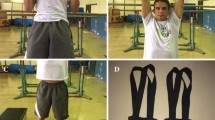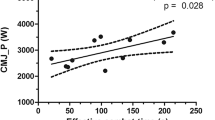Abstract
The objectives of this study were to develop normative tables to classify judo athletes by maximal isometric strength and muscular power, and to compare performance at different competitive levels. 102 male athletes performed tests of maximal isometric handgrip strength (MIHS), scapular humeral traction (MISHT), lumbar traction (MILT), lower body traction (MILBT), plyometric push-up (PPU), countermovement jump (CJ) and squat jump (SJ). Performance was classified as: ≤ 10th percentile = very poor, 11–25th percentile = poor, 26–75th percentile = regular, 76–90th percentile = good and > 90th percentile = excellent. Classification relative to body mass [isometric (kg/kg) and power (cm kg)] was as follows: MIHS—very poor: ≤ 0.81; poor: 0.82–0.96; regular: 0.97–1.51; good: 1.52–1.79; excellent: ≥ 1.80, MILT—very poor: ≤ 1.14; poor: 1.15–1.41; regular: 1.41–2.0; good: 2.0–2.5; excellent: ≥ 2.6, MILBT—very poor: ≤ 1.15; poor: 1.16–1.44; regular: 1.45–2.15; good: 2.16–2.62; excellent: ≥ 2.63, MISHT—very poor: ≤ 0.34; poor: 0.35–0.41; regular: 0.42–0.62; good: 0.63–0.73; excellent: ≥ 0.74, PPU—very poor: ≤ 635.4; poor: 635.5–901.9; regular: 902.0–1801.4; good: 1801.5–2369.7; excellent: ≥ 2369.8, SJ—very poor: ≤ 1690.7; poor: 1690.8–1990.3; regular: 1990.4–3387.9; good: 3388.0–4029.4; excellent: ≥ 4029.5 and CJ—very-poor: ≤ 1775.4; poor: 1775.5–2195.4; regular: 2195.5–3667.2; good: 3667.3–4208.3; excellent: ≥ 4208.4. State athletes had lower MISHT (p = 0.015) than international athletes and lower CJ than national athletes (p = 0.05). International athletes showed better PPU performance than others (p < 0.05). MIHS, MISHT and PPU were sensitive to identify differences between competitive level of judo athletes (state, national and international level).


Similar content being viewed by others
Change history
28 November 2020
A Correction to this paper has been published: https://doi.org/10.1007/s11332-020-00720-9
Abbreviations
- MIHS:
-
Maximal isometric handgrip strength
- MILT:
-
Maximal isometric lumbar traction
- MILBT:
-
Maximal isometric lower body traction
- MISHT:
-
Maximal isometric scapular humeral traction
- PPU:
-
Plyometric push-up
- SJ:
-
Squat jump
- CJ:
-
Countermovement jump
- VJ:
-
Vertical jump
- ICC:
-
Interclass coefficient
References
Aruga S, Nakanishi H, Yamashita Y, Onda T, Ubukata K (2003) A study on the training method for improving judo players’ kumite strength: on the judogi chin-up method. Tokai J Med Sci Res Inst Sport Med Sci 18:44–53
Athayde MSS, Kons RL, Detanico D (2016) Influência da gordura corporal no desempenho do salto com contra-movimento em judocas de diferentes categorias de peso. Rev Bras Educ Fis Esporte, Brazil (Epub ahead of print, in Portuguese)
Bonato M, Rampichini S, Ferrara M, Benedini S, Sbriccoli P, Merati G, Franchini E, La Torre A (2015) Aerobic training program for the enhancements of HR and VO2 off-kinetics in elite judo athletes. J Sports Med Phys Fitness 55(11):1277–1284
Bonitch-Góngora JG, Bonitch-Domíngues JG, Padial P, Feriche B (2012) The effect of lactate concentration on handgrip strength during judo bouts. J Strength Cond Res 26:1863–1871. https://doi.org/10.1519/JSC.0B013E318238EBAC
Branco BHM, Franchini E (2017) Entrenamiento De La Fuerza Máxima En Luchadores. In: Franchini E, Herrera-Valenzuela T (eds) Preparación Física Para Deportes De Combate. Editorial Kinesis, Armenia, pp 155–229
Branco BHM, Andreato LV, Miarka B, Moraes SMF, Esteves JV, Massuça LM (2017) Time-motion analysis and patterns of salivary cortisol during different judo championship phases. Sport Sci Health 13:419–426. https://doi.org/10.1007/s11332-017-0376-3
Branco BHM, Diniz E, Santos JFS, Shiroma SA, Franchini E (2017) Normative tables for the dynamic and isometric judogi chin-up tests for judo athletes. Sport Sci Health 13:47–53. https://doi.org/10.1007/s11332-016-0331-8
Branco BHM, Lopes-Silva JP, da Silva Santos JF, Julio UF, Gonçalves Panissa VL, Franchini E (2017) Monitoring training during four weeks of three different modes of high-intensity interval training in judo athletes. Arch Budo 13:51–62
Branco BHM, Massuça L, Andreato LV, Miarka B, Monteiro L, Marinho BF, Franchini E (2013) Association between the rating of perceived exertion, heart rate and blood lactate in successive judo fights (Randori). Asian J Sports Med 4:125–130
Cavazzotto TG, Tratis L, Ferreira SA, Fernandes RA, Queiroga MR (2012) Muscular static strength test performance: comparison between normotensive and hypertensive workers. Rev Assoc Med Bras 58:574–579
Cohen J (1988) Statistical power analysis for the behavioral sciences. Lawrence Erlbaum, Hillsdale
Coldwells G, Atkinson G, Reilly T (1994) Sources of variation in back and leg dynamometry. Ergonomics 37:79–86
Del Vecchio FB, Dimare M, Franchini E, Schaun GZ (2014) Physical fitness and maximum number of all-out hikidashi uchi-komi in judo practitioners. Med Sport 67:383–396
Del Vecchio FB, Rosa RR, Michelini AH (2003) Proposta de teste para mensurar salto vertical de membros superiores em lutadores de karatê. In: XXVI Simpósio Internacional de Ciências do Esporte, São Paulo, 23 a 25 de outubro, p 48
Detanico D, Dal Pupo J, Graup S, Dos Santos SG (2016) Vertical jump performance and isokinetic torque discriminate advanced and novice judo athletes. Kinesiology 48:223–228
Detanico D, Dal Pupo J, Franchini E, Dos Santos SG (2015) Effect of successive judo matches on fatigue and muscle damage markers. J Strength Cond Res 29:1010–1016. https://doi.org/10.1519/JSC.0000000000000746
Field A (2009) Discovering statistics using SPSS. SAGE, London
Finni T, Ikegawa S, Kallio J, Lepola V, Komi PV (2001) Vastus lateral’s length and force in isometric and stretch-shortening cycle conditions. J Sports Sci 19:550–551
Fonseca NT, Cavalcanti TR, Maia TO, Urbano JJ, Santos IR, Coelho AC (2013) Análise da força dos músculos estabilizadores da escápula em pacientes com dor no ombro. Ter Man 11:378–383
Franchini E, Artioli GG, Brito CJ (2013) Judo combat: time-motion analysis and physiology. Int J Perform Anal Sport 13:624–641
Franchini E, Del Vecchio FB, Sterkowicz S (2009) A special judo fitness test classificatory table. Arch Budo 5:127–129
Franchini E, Del Vecchio FB, Matsushigue KA, Artioli GG (2011) Physiological profiles of elite judo athletes. Sports Med 41:147–166. https://doi.org/10.2165/11538580-000000000-00000
Franchini E, Takito MY, Kiss MAPDM., Sterkowicz S (2005) Physical fitness and anthropometrical differences between elite and non-elite judo players. Biol Sport 22:315–328
Heyward VH (1996) Evaluation of body composition—current issues. Sport Med 22:146–156
Hopkins WG. A scale of magnitudes for effect statistics. In: http://www.sportsci.org/resource/stats/ Accessed 18 Mar 2018
Harriss DJ, Macsween A, Atkinson G (2017) Standards for ethics in sport and exercise science research: 2018 update. Int J Sports Med 38:1126–1131. https://doi.org/10.1055/s-0043-124001
International Judo Federation (IJF). In: https://www.ijf.org/ijf/documents/5 Accessed on 24 Jan 2018
International Olympic Committee (IOC). In: https://www.olympic.org/news/friendship-and-courage-are-key-in-the-chase-for-tokyo-2020-mixed-team-gold Accessed 24 Jan 2018
Kano J (2009) Judô Kodokan. Cultrix, São Paulo
Komi PV, Bosco C (1978) Utilization of stored elastic energy in leg extensor muscles by men. Med Sci Sport Exerc 10:261–265
Little NG (1991) Physical performance attributes of junior and senior women, juvenile, junior and senior men judokas. J Sports Med Phys Fitness 31:510–520
Magnani Branco BH, Andreato LV, Mendes AA, Gilio GR, Andrade A, Júnior NN (2016) Effects of a Brazilian jiu-jitsu training session on physiological, biochemical, hormonal and perceptive responses. Arch Budo Sci Martial Art Extreme Sport 12:145–154
Marques García FJ, Fernández Garcia JC (2012) Assessment of upper body strength with touch pad. Rev Int Med Ciencias Actividad Fisica Deporte 12:35–51
Mathiowetz V, Weber K, Volland G, Kashman N (1984) Reliability and validity of grip and pinch strength evaluations. J Hand Surg Am 9:222–226
Miarka B, Cury R, Julianetti R, Battazza R, Julio UF, Calmet M, Franchini E (2014) A comparison of time-motion and technical-tactical variables between age groups of female judo matches. J Sports Sci 32:1529–1538. https://doi.org/10.1080/02640414.2014.903335
Moraes MG, Borba-Pinheiro CJ, Marson AR, Rodrigues LC, Dos Reis AS, Da Silva JN (2017) Correlation between maximum isometric strength variables and specific performance of Brazilian military judokas. Motricidade 13:68–76
Ramírez-Vélez R, Lópes-Albán CA, Rotta-Villamizar DRL, Romero-García JA, Alonso-Martinez AM, Izquierdo M (2015) Wingate anaerobic test percentile norms in Colombian healthy adults. J Strength Cond Res 30:217–225. https://doi.org/10.1519/JSC.0000000000001054
Slinde F, Suber C, Suber L, Edwén CE, Svantesson U (2008) Test-retest reliability of three different countermovement jumping tests. J Strength Cond Res 22:640–644. https://doi.org/10.1519/JSC.0b013e3181660475
Sterkowicz-Przybycień KL, Fukuda DH (2014) Establishing normative data for the special judo fitness test in female athletes using systematic review and meta-analysis. J Strength Cond Res 28:3585–3593. https://doi.org/10.1519/JSC.0000000000000561
Thomas SG, Cox MH, Legal YM, Verde TJ, Smith HK (1989) Physiological profiles of the Canadian judo team. Can J Sport Sci 14:142–147
Vidal Andreato L, Franzói de Moraes SM, Lopes de Moraes Gomes T, Del Conti Esteves JV, Vidal Andreato T, Franchini E (2011) Estimated aerobic power, muscular strength and flexibility in elite Brazilian Jiu-jitsu athletes. Sci Sports 26:329–337. https://doi.org/10.1016/j.scispo.2010.12.015
World Anti-Doping Agency (WADA) The prohibited list. IOP Publishing Physics Web. https://wada-main-prod.s3.amazonaws.com/resources/files/wada-2015-prohibited-list-en.pdf. Accessed 26 May 2016
Funding
This study was funded by the authors.
Author information
Authors and Affiliations
Corresponding author
Ethics declarations
Conflict of interest
The authors declare that there are no conflicts of interests.
Ethical approval
The study was approved by the local ethics committee (57428916.9.0000.0104 - State University of Maringá, Paraná, Brazil). The study followed the recommendations of the Helsinki Declaration.
Informed consent
All athletes signed the informed consent to participate in the present study.
Rights and permissions
About this article
Cite this article
Branco, B.H.M., Andreato, L.V., Ribeiro, E.D. et al. Development of tables for classifying judo athletes according to maximal isometric strength and muscular power, and comparisons between athletes at different competitive levels. Sport Sci Health 14, 607–614 (2018). https://doi.org/10.1007/s11332-018-0469-7
Received:
Accepted:
Published:
Issue Date:
DOI: https://doi.org/10.1007/s11332-018-0469-7




